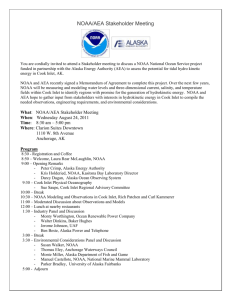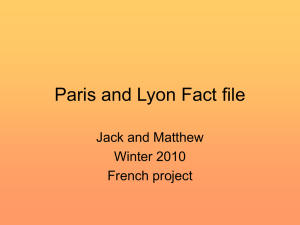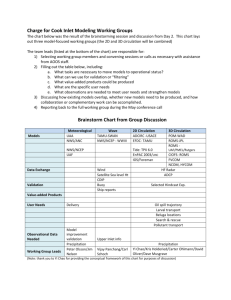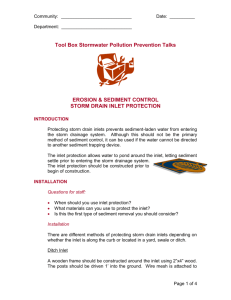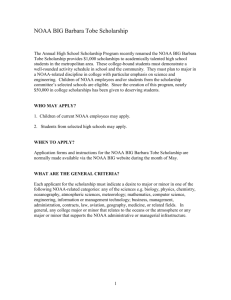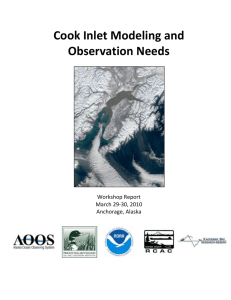Call Summary - Alaska Ocean Observing System
advertisement
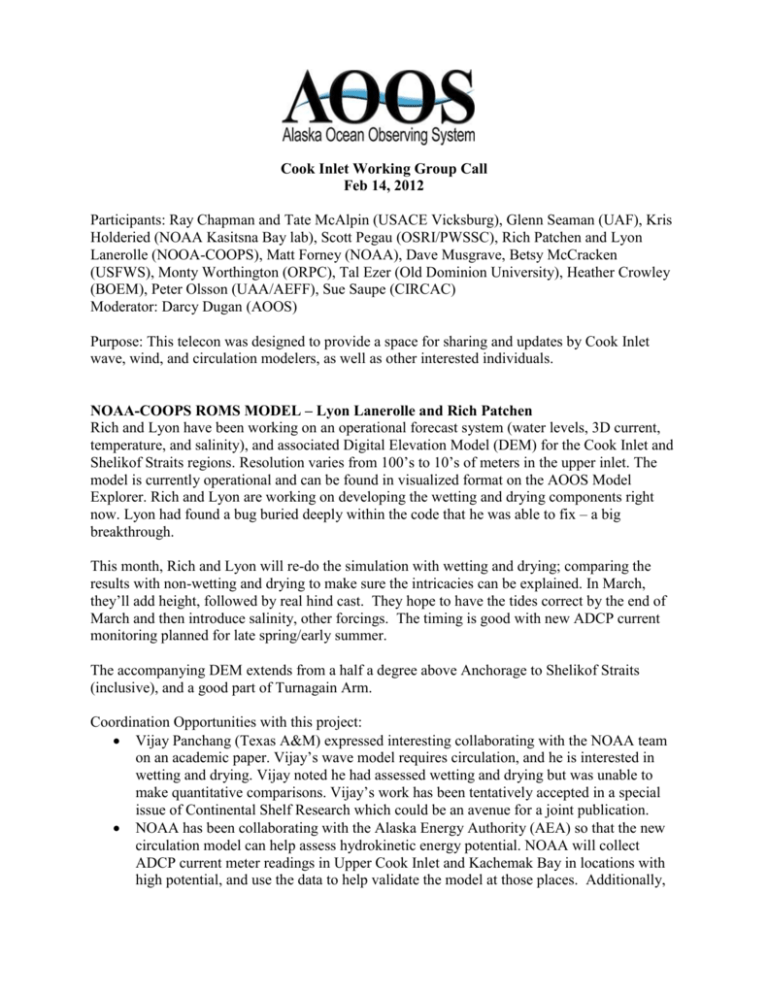
Cook Inlet Working Group Call Feb 14, 2012 Participants: Ray Chapman and Tate McAlpin (USACE Vicksburg), Glenn Seaman (UAF), Kris Holderied (NOAA Kasitsna Bay lab), Scott Pegau (OSRI/PWSSC), Rich Patchen and Lyon Lanerolle (NOOA-COOPS), Matt Forney (NOAA), Dave Musgrave, Betsy McCracken (USFWS), Monty Worthington (ORPC), Tal Ezer (Old Dominion University), Heather Crowley (BOEM), Peter Olsson (UAA/AEFF), Sue Saupe (CIRCAC) Moderator: Darcy Dugan (AOOS) Purpose: This telecon was designed to provide a space for sharing and updates by Cook Inlet wave, wind, and circulation modelers, as well as other interested individuals. NOAA-COOPS ROMS MODEL – Lyon Lanerolle and Rich Patchen Rich and Lyon have been working on an operational forecast system (water levels, 3D current, temperature, and salinity), and associated Digital Elevation Model (DEM) for the Cook Inlet and Shelikof Straits regions. Resolution varies from 100’s to 10’s of meters in the upper inlet. The model is currently operational and can be found in visualized format on the AOOS Model Explorer. Rich and Lyon are working on developing the wetting and drying components right now. Lyon had found a bug buried deeply within the code that he was able to fix – a big breakthrough. This month, Rich and Lyon will re-do the simulation with wetting and drying; comparing the results with non-wetting and drying to make sure the intricacies can be explained. In March, they’ll add height, followed by real hind cast. They hope to have the tides correct by the end of March and then introduce salinity, other forcings. The timing is good with new ADCP current monitoring planned for late spring/early summer. The accompanying DEM extends from a half a degree above Anchorage to Shelikof Straits (inclusive), and a good part of Turnagain Arm. Coordination Opportunities with this project: Vijay Panchang (Texas A&M) expressed interesting collaborating with the NOAA team on an academic paper. Vijay’s wave model requires circulation, and he is interested in wetting and drying. Vijay noted he had assessed wetting and drying but was unable to make quantitative comparisons. Vijay’s work has been tentatively accepted in a special issue of Continental Shelf Research which could be an avenue for a joint publication. NOAA has been collaborating with the Alaska Energy Authority (AEA) so that the new circulation model can help assess hydrokinetic energy potential. NOAA will collect ADCP current meter readings in Upper Cook Inlet and Kachemak Bay in locations with high potential, and use the data to help validate the model at those places. Additionally, Rich has a lot of historical data that will be factored into the validation. They are still trying to finalize the locations; the main issue is the risk of loss of the instruments since the current is so fast. They are trying to come up with balance of logistics for needed data while minimizing potential for loss. When the new data collection locations are set, they will inform the group. Sharing the DEM: A standard DEM is critical for intercomparisons between models. The DEM is currently available for use by researchers by contacting Lyon. Additional refinements will be made as the project progresses, but he has already shared it with several interested parties in netcdf format. Lyon and Rich will be working on a clear disclaimer that the DEM is for modeling and visualization purposes only, and not for navigation. They would like to speak with the users of the DEM before distributing. Texas A&M SWAN model - Vijay Panchang. The TAMU team is having a transition in personnel as Guarav Singhal left in October to join the offshore industry. His successor, Abhishek Sharma, has already been working on Cook Inlet SWAN modeling in other capacities and should be up to speed shortly. They have produced a Continental Shelf paper primarily focusing on waves in Prince William Sound, but includes Cook Inlet. The paper just went through another round of revisions. U.S. Army Corps Circulation Modeling -- Ray Chapman Recent work by the USACE in Cook Inlet has related to Port of Anchorage, and circulation under different scenarios of port expansion. They are working with an ADH numerical model, and have validated it to same time period as their ADCIRC model. So far they’ve gotten comparable answers. They can also link the ADH with water quality models. NOAA Kasitsna Bay Lab and Kachemak Research Reserve – Kris Holderied A long term monitoring project funded by EVOS includes money for routine oceanographic surveys. CTD casts will be done in transects from the Homer Spit, across the Kachemak Bay entrance, and in a box in lower Cook Inlet. In addition, KBRR was funded by CIAP to conduct drifter surveys, led by Mark Johnson at UAF. The drifters will be looking at exchanges coming into Kachemak Bay, where fresh water from head of the bay is going, and exchanges between the main bay stem and sub bays. The intent is to keep ahold of the drifters! This effort is being coordinated with Rich and Lyon and the NOAA circulation modeling efforts. According to the discussion, most any of the data will be useful. The first drifter deployments in May or June, and Megan Murphy is the lead at KBRR. Alaska Interagency Hydrographic Survey Work Group -- Matt Forney In January, Matt launched the Alaska Interagency Hydrographic Survey Work Group, which will meet quarterly by teleconference. Matt is the NOAA Navigation Manager for Alaska. The hydrographic initiative came about after a near miss when two groups almost spent a lot of money last year to survey the same area. The first call was a successful opportunity for partners to connect. Matt noted collaboration surrounding a ship headed to the Arctic this summer -- six groups from state, federal, and local entities expressed interest in putting people/resources on board to do more science. They may even conduct a joint spill drill. Email Matt if you are interested in joining the group: Matthew.Forney@noaa.gov Bureau of Ocean Energy (BOEM) -- Heather Crowley Cook Inlet is moving into BOEM’s line of site, and they may soon be looking for a long term 20year hindcast. BOEM is particularly interested in surface currents and accompanying wind forcing which would be used for oil spill trajectory models for planning purposes. Vijay Panchang mentioned he has frequently developed hindcasts for different parts of US coast and is just about to submit paper on the Gulf of Mexico from the standpoint of extreme damage. Someone (Vijay or Rich) also noted there’s about 15-20 yrs of wind fields available from NOAA and while there’s some uncertainty associated with the fields, he could produce something in short order. Heather will get in touch with Rich Patchen and Vijay. Heather was also interested in modeling that included sea ice. Rich and Lyon’s NOAA model does not include sea ice, but it was noted that ROMS does has an ice model component. Heather is working with an Arctic model that’s being run with ice. She noted that BOEM won’t have much time when they need the data, and would like to know who might be available to help if they find they need to look for data/model output resources with short notice. Peter Olsson, AK Experimental Forecast Facility/UAA Peter provided an update on his WRF model for southcentral Alaska. He has continued to forecast the with 2-grid nested Prince William Sound-WRF (STD) and the 3-km x Prince William Sound -WRF variants: 3KM and MPH producing 48-h forecasts twice daily STD and 3KM have proved to be quite robust operationally. The MPH run— with its more complex physics— has about a 98% completion success rate. MPH crashes tend to occur near the end of the 48 h forecast period– within a few hours of completion. While they seem to occur more frequently with high winds and stable boundary layers, they have yet to diagnose the exact cause and nature of the model error. Beyond the operational forecasting, Peter and his team have been conducting developmental work– in particular in the development of high vertical resolution variants. The MPX variant has the same model physics and horizontal grid geometry as the MPH, but has an additional 14 vertical levels, with most of the increase near the surface, giving MPX an 8-m surface resolution. The MPX has similar (but more frequent) run-time pathologies as those noted above for MPH. They continue to work this issue. Another variant under development– Gulf of Alaska (GOA)– is much larger spatially: 480x400 pts at 3-km x. GOA shares MPH’s physics and vertical grid geometry, yet spans most of the Gulf of Alaska (hence the name). While this grid is too large to run for real time forecasting purposes, it is a very useful research tool, especially when examining storms that are only on the periphery of the MPH grid. The third variant under development, GOX, is a marriage of GOA and MPX (i.e., better vertical resolution), and is again mostly a research tool. Collaborations surrounding this project Peter has foraged collaborations with several researchers and agencies including the Anchorage Department of Health and Human Services and researchers in the Copper River Area who share an interest in dust storms. They also continue to work with PWS mariners on uses and interpretation of both observed and modeled wind data. AEFF will soon be sharing all forecasts with the NWS Anchorage Forecast Office. They’ve been successful in developing a method of automatically converting WRF files to the GRIB2 format needed by the Weather Service, and are currently negotiating with UAA and the Weather Service on details of the network transfer. Peter and Rich Patchen discussed data sharing. Peter has 4km data back to 2007, and then it slips back into when they were running RAM which was also 4km. That data goes back to 2003 or 2004, but the software to get it off the tape is on a skuzzy drive and they don’t have anything to support a skuzzy drive. Peter is ready to work on this when Rich wants it and Rich said he would ask when he was ready. This year has brought into sharp focus that it can be almost totally covered in ice. WRF hasn’t dealt with sea ice in the past. This year might be more of an issue. Peter would like to get the lat/long of new Snotel weather station that will be deployed by CIRCAC and AOOS at McNeil River this spring. As Peter extracts data points from the model data, its’ time intensive and he could be more efficient by targeting that point. Other Updates: UAA engineering professor Tom Ravens is working on a DEM for east forelands. (Tom was not on the call) Rich Patchen noted that Monty Worthington at the Ocean Renewable Power Company has been very helpful in making decision for locations for current meters. Other data needs mentioned o More Snotel stations on the west side of inlet (Peter Olsson) o Tide gauge measurements are needed by CO-OPS. Kris Holderied is thinking about working with park service to put in station for 90 days. USACE and TAMU would also be interested in water level data on the western side of Cook Inlet. o Winds in the western inlet would be useful. Vijay mentioned his SWAN model uses wind forcing from Peter’s model but sometimes it’s not sufficient. The group talked about looking into the NAM 4km meteorological forecast as part of a new national program. There were questions about how it handles mountains, which could lead to small scale error. Tal Ezer from Old Dominion University noted he uses a combination of several stations around the inlet for wind. Instead of using a forecast, he simply analyzed the data. Next meeting date in late March/early April – TBA.
